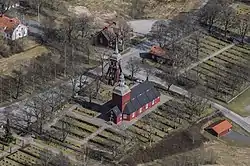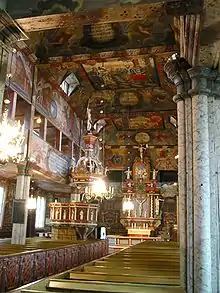Habo Municipality
Habo kommun | |
|---|---|
 | |
 Coat of arms | |
 | |
| Coordinates: 57°55′N 14°04′E / 57.917°N 14.067°E | |
| Country | Sweden |
| County | Jönköping County |
| Seat | Habo |
| Area | |
| • Total | 462.24 km2 (178.47 sq mi) |
| • Land | 328.52 km2 (126.84 sq mi) |
| • Water | 133.72 km2 (51.63 sq mi) |
| Area as of 1 January 2014. | |
| Population (31 December 2021)[2] | |
| • Total | 12,810 |
| • Density | 28/km2 (72/sq mi) |
| Time zone | UTC+1 (CET) |
| • Summer (DST) | UTC+2 (CEST) |
| ISO 3166 code | SE |
| Province | Västergötland |
| Municipal code | 0643 |
| Website | www.habokommun.se |
Habo Municipality (Swedish: Habo kommun) is a municipality in Jönköping County, southern Sweden, where the locality of Habo is seat.
The present municipality was formed in 1974 when a part of the dissolved rural municipality of Fågelsås was amalgamated with "old" Habo. It was transferred from the dissolved Skaraborg County to Jönköping County in 1998.
Geography
Things to do in the municipality include activities related to the lake Vättern, such as fishing, bathing and hiking. It offers plenty of nature and outdoor activities. Just outside the seat is a forest of beech woods planted by count Per Brahe the younger in the 17th century and lovely for recreational walks. And within the municipality two areas have been deemed important enough to be nature reserves: Fiskebäck has a moist ground where hazel and oak have claimed most of the space in competition with aspen, bird cherry, birch, sallow, hawthorn, beech and ash; while Hökensås is distinguished by a varied terrain of valleys and slopes with some 50 tarns and small lakes and a fauna of great variety.
Localities
There are 3 urban areas (also called a Tätort or locality) in Habo Municipality.
In the table the localities are listed according to the size of the population as of December 31, 2005. The municipal seat is in bold characters.
| # | Locality | Population |
|---|---|---|
| 1 | Habo | 6,244 |
| 2 | Furusjö | 344 |
| 3 | Fagerhult | 317 |
Demographics
This is a demographic table based on Habo Municipality's electoral districts in the 2022 Swedish general election sourced from SVT's election platform, in turn taken from SCB official statistics.[3]
Residents include everyone registered as living in the district, regardless of age or citizenship status. Valid voters indicate Swedish citizens above the age of 18 who therefore can vote in general elections. Left vote and right vote indicate the result between the two major blocs in said district in the 2022 general election. Employment indicates the share of people between the ages of 20 and 64 who are working taxpayers. Foreign background is defined as residents either born abroad or with two parents born outside of Sweden. Median income is the received monthly income through either employment, capital gains or social grants for the median adult above 20, also including pensioners in Swedish kronor. The section about college graduates indicates any degree accumulated after high school.
In total there were 12,805 residents, including 9,141 Swedish citizens of voting age.[3] 39.4 % voted for the left coalition and 59.2 % for the right coalition.
| Location | Residents | Valid voters | Left vote | Right vote | Employed | SV parents | 1st/2nd gen | Income | College |
|---|---|---|---|---|---|---|---|---|---|
| % | % | % | % | % | % | ||||
| Bränninge | 2,487 | 1,563 | 42.1 | 56.3 | 89 | 87 | 13 | 29,611 | 55 |
| Centrum-Gunnarsbo | 1,895 | 1,374 | 44.7 | 53.9 | 81 | 81 | 19 | 22,979 | 34 |
| Gustav Adolf-Brandstorp | 1,827 | 1,344 | 32.2 | 66.3 | 87 | 92 | 8 | 26,778 | 30 |
| Kråkeryd-Mölekullen | 1,837 | 1,292 | 42.5 | 56.4 | 89 | 90 | 10 | 29,910 | 47 |
| Kyrkbyn-Furusjö | 1,496 | 1,107 | 33.6 | 64.8 | 90 | 93 | 7 | 27,526 | 31 |
| Kärnekulla-Sjogarp | 1,551 | 1,242 | 32.9 | 65.7 | 91 | 93 | 7 | 33,040 | 50 |
| Kärr | 1,712 | 1,219 | 45.6 | 54.0 | 91 | 92 | 8 | 28,380 | 49 |
| Source: SVT[3] | |||||||||
Schools
- Bränningeskolan 1975-
- Fagerhults skola 1910-
- Gröne Vägens Skola 1931-
- Habo Centralskola 1953-1998 (Divided in 1998. Grades F-5 became Hagenskolan, grades 6-9 became Hagabodaskolan)
- Hagenskolan 1998-
- Hagabodaskolan 1998-
- Kråkerydsskolan 1976-
- Malmgårdsskolan 1996-
Sports
- BIF Fagerhult, formed 1949. floorball late 1980s-
- Habo Handboll, formed 1990. team handball 1990-
- Habo IF, formed April 26, 1926. association football 1926- earlier even other sports, for example bandy (1926-1998)
- Habo Wolley, formed 1987. volleyball
- Hagaboda SK, formed 1989. floorball
- Yellow Obah, formed 1995. volleyball (Farm team to Habo Wolley)
Sights

See also
- Because diacritics are often dropped on the English oriented Internet, Habo is sometimes confused with Håbo Municipality, located in the province of Uppland (near Stockholm).
References
- Unless otherwise stated, the material is found on the official webpage
- 1: Incorporated from sv:Habo kyrka
- 2: article Habo from Nordisk Familjebok (1909)
- Statistics Sweden
- ↑ "Statistiska centralbyrån, Kommunarealer den 1 januari 2014" (in Swedish). Statistics Sweden. 2014-01-01. Archived from the original (Microsoft Excel) on 2016-09-27. Retrieved 2014-04-18.
- ↑ "Folkmängd i riket, län och kommuner 31 december 2021" (in Swedish). Statistics Sweden. February 22, 2022. Retrieved February 22, 2022.
- 1 2 3 "Valresultat 2022 för Habo i riksdagsvalet" (in Swedish). SVT. 11 September 2022. Retrieved 7 January 2024.
External links
- Habo Municipality - Official site